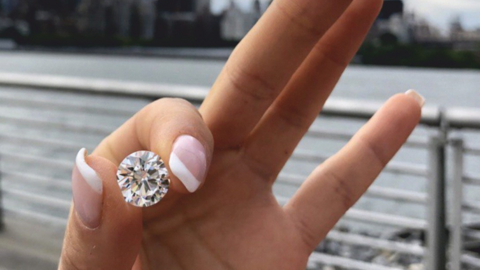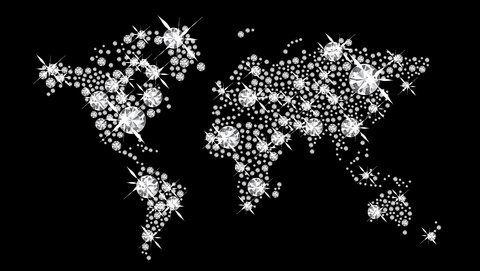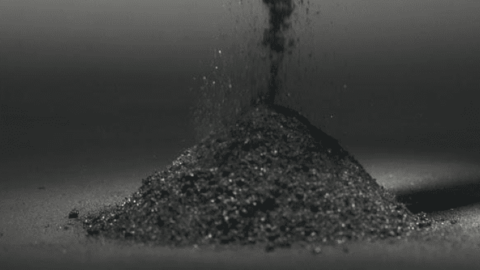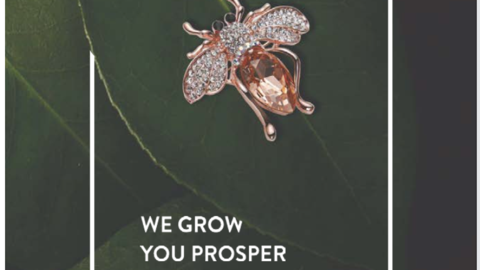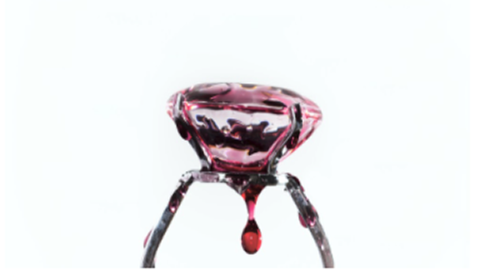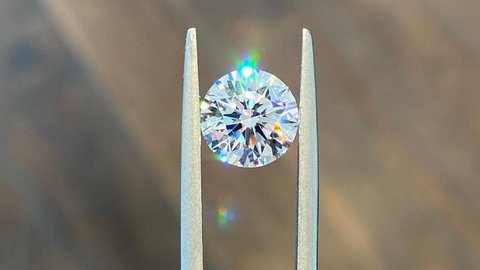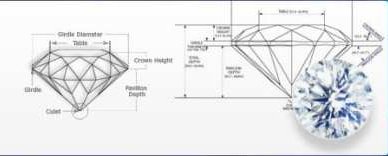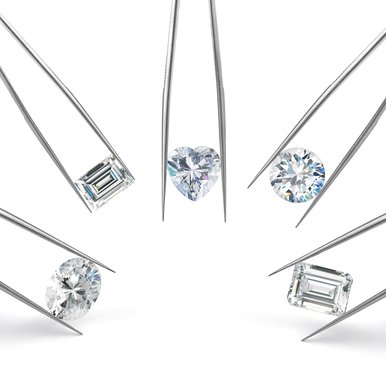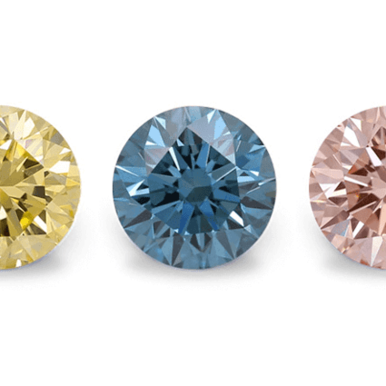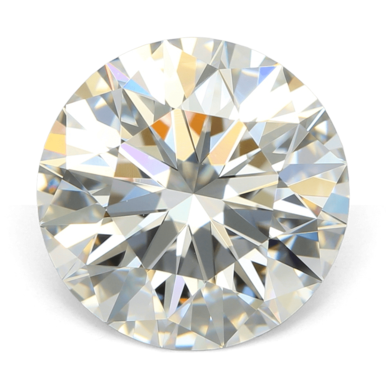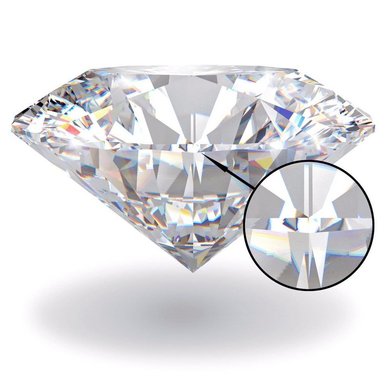Princess Cut Lab-Grown Diamond Rings: Modern Elegance Redefined
Author: Alex K., CMO at Labrilliante Updated: 2025-11-18 Reading Time: 12 minutes
TL;DR: Princess cuts utilize 80% of rough crystal versus 50% for rounds—geometric efficiency that saves 15-30% before you even compare lab-grown to mined pricing. Their 76-facet architecture and square profile deliver 10-15% larger visual presence per carat. Manufacturer-direct channels offer 1-carat stones under $1,600 and 2-carat diamonds under $4,800 with IGI certification, complete supply chain transparency, and customizable settings from minimalist solitaires to architectural halos.
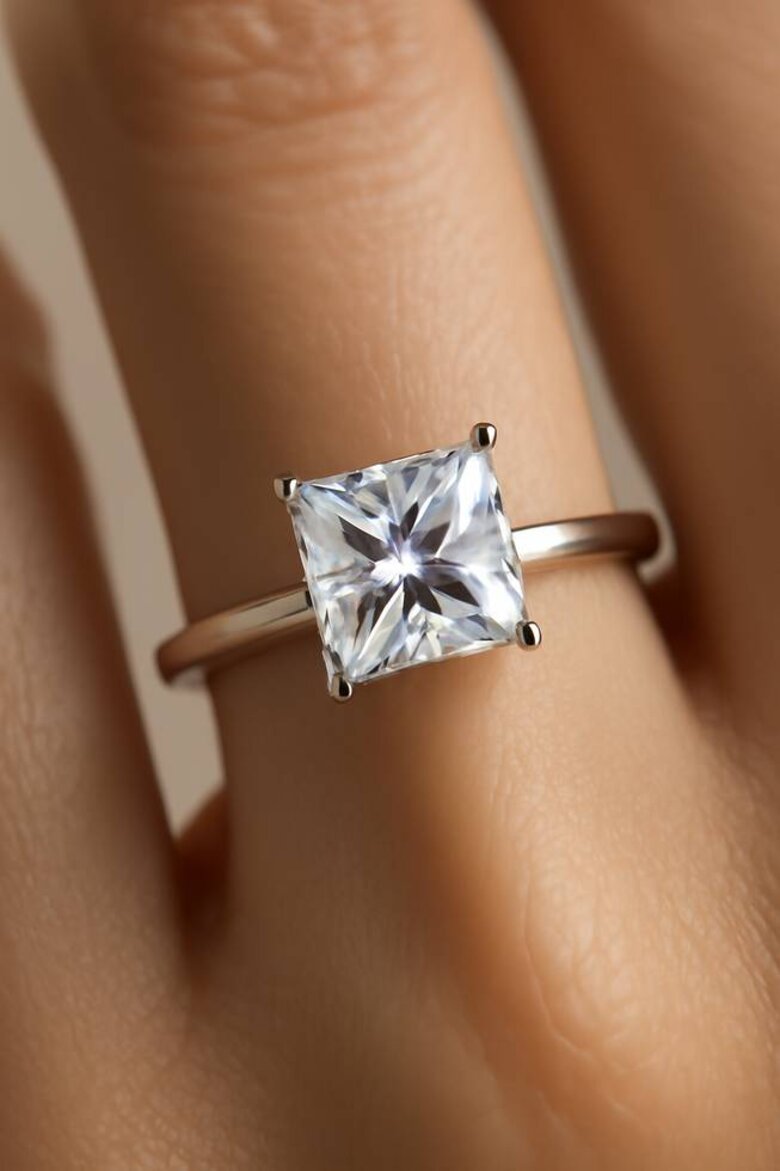
Modern brides reject cookie-cutter tradition. They demand jewelry that mirrors their values—bold geometry over predictable rounds, verified ethics over vague promises, smart budgeting over unnecessary markups. Princess cut lab-grown diamond rings answer this cultural shift with 76 facets of architectural fire, conflict-free molecular origins, and 60-80% cost savings that redirect thousands toward honeymoons or down payments. This guide reveals how geometric precision, manufacturer-direct pricing, and IGI certification transform engagement ring shopping from compromise into strategic empowerment.
The Resale Reality: Why Mined Diamonds Still Hold Secondary Market Advantage
Critics argue lab-grown diamonds lack resale value, pointing to secondary markets where natural stones retain 25-50% of retail price while lab-grown equivalents fetch minimal returns. This concern carries weight for buyers viewing engagement rings as financial assets. Natural diamond scarcity creates theoretical value retention—geological rarity can't be manufactured away.
Here's the honest assessment: They're right about current resale dynamics. But they're wrong about what matters. Traditional retail purchases lose 60-75% of value the moment you leave the store due to markup structure, whether mined or lab-grown. A $7,000 mined princess cut has $2,000-2,800 wholesale value. A $1,400 lab-grown equivalent has $600-800 production cost. Neither represents sound financial investment.
The real question? Do you buy an engagement ring as a depreciating consumer good worn daily for decades, or as a speculative asset locked in a safe? For 95% of buyers prioritizing maximum visual impact, ethical sourcing, and smart capital allocation, lab-grown optimization wins. For the 5% treating diamonds as portable wealth storage, natural stones merit consideration—but that's investment strategy, not romance.
Modern Geometric Brilliance: The Contemporary Princess Cut Renaissance
Princess cut lab-grown diamonds combine 76 precisely angled facets with bold 90-degree corners to create exceptional architectural fire. This makes them the second most popular engagement ring cut among contemporary brides seeking geometric perfection over traditional round brilliants.
The princess cut emerged in the 1960s as an answer to round brilliant dominance. Unlike rounds that waste approximately 50% of rough material, princess cuts utilize up to 80% of the original crystal—a geometric efficiency that translates directly to cost savings. Sharp corners require protective prong settings. Those pointed edges are more vulnerable to chipping than rounded cuts.
The square shape creates visual length on fingers. It appears approximately 10-15% larger than round diamonds of identical carat weight due to surface area. The length-to-width ratio becomes critical. Ideal proportions between 1.00 and 1.05 create perfect squares, while ratios up to 1.10 produce subtle rectangles that elongate fingers.
[Placeholder Table: Princess Cut vs. Round Brilliant vs. Other Popular Cuts - Complete Specification Comparison - Helps buyers understand exactly how princess cuts differ in facet count, material efficiency, visual size, price point, and ideal settings compared to rounds, cushions, ovals, and emerald cuts across all decision factors]
Why Princess Cut Lab Diamonds Define Modern Engagement Style
Between 1990 and 2010, princess cuts accounted for roughly 25-30% of engagement ring sales. That popularity stems from distinctive personality projection. Where round brilliants signal timeless tradition, princess cuts communicate bold statements and empowered decisions.
The geometric perfection resonates with buyers who value modern architecture, clean interior design, and minimalist fashion. This popularity creates an interesting dynamic. Princess cuts offer simultaneous mass appeal and distinctive individuality.
[Placeholder Image: Princess Cut Diamond on Hand Showing Geometric Angles and Corner Detail - Visual demonstration of how the square shape creates finger length and showcases the distinctive 90-degree corners and facet pattern that defines princess cut personality]
Architectural Precision Meets 76-Facet Fire and Light Performance
The 76-facet arrangement distinguishes princess cuts from all other square shapes. The pavilion features inverted pyramids meeting at the culet, while chevron facets radiate from the table in precise angular relationships. Think of it as acoustic engineering for light.
Table percentages between 65-75% balance brilliance with fire. Depth percentages from 68-74% optimize light return without creating dead zones or excessive weight below the girdle.
CVD growth creates princess cut rough with crystallographic advantages. Type IIa crystal structure allows superior light transmission across the visible spectrum compared to Type Ia natural diamonds that contain nitrogen aggregates. This molecular purity translates to whiter appearance in near-colorless grades and enhanced fire in lower color grades.
[Placeholder Infographic: Princess Cut Light Performance Pathway - 76-Facet Structure Visualization - Technical breakdown showing how light enters through the table, travels through chevron facets, reflects off inverted pyramid pavilion, and returns as brilliance and fire, with optimal table (65-75%) and depth (68-74%) percentages marked for buyer understanding]
Excellent symmetry ensures opposing facets align within microscopic tolerances. This prevents light leakage through mismatched junctions. A princess cut with "Very Good" symmetry might show subtle brightness variations when viewed through an Ideal-Scope, while "Excellent" ratings demonstrate uniform patterns.
The modified brilliant cut classification means princess shapes share brilliance characteristics with rounds while introducing unique fire properties. Fire—the dispersion of white light into spectral colors—intensifies in princess cuts. The pavilion's steep angles bend light beyond diamond's critical angle of 24.4 degrees, separating wavelengths more dramatically than shallower round pavilions.
Second Most Popular Cut: Geometric Perfection for Today's Brides
Market data consistently places princess cuts between 20-28% of engagement ring sales. They trail only round brilliants at 50-60% but significantly outperform cushions (8-12%), ovals (5-8%), and emerald cuts (3-5%). This sustained popularity across three decades demonstrates enduring appeal rather than temporary trend status.
The geometric design language speaks to contemporary brides who express personal style through architectural jewelry. Millennials and Gen-Z show markedly more diverse cut preferences reflecting broader cultural values around individuality and conscious choice.
Geometric perfection as a value proposition extends beyond aesthetics into practical considerations. The square outline simplifies setting design. Four-prong mountings place precious metal exactly at corners where protection is needed, while halo designs create clean horizontal and vertical axes.
Lab-Grown vs Mined Diamond Value: Manufacturer-Direct Price Transparency
Laboratory-grown princess cut diamonds deliver 60-80% cost savings compared to mined equivalents of identical specifications. Manufacturer-direct pricing eliminates the traditional retail markup structure that adds 200-400% to wholesale costs. This fundamental economic shift transforms engagement ring budgeting.
[Placeholder Table: Lab-Grown vs. Mined Princess Cut Price Comparison by Carat Weight - Real Cost Breakdown showing 1-carat, 1.5-carat, and 2-carat princess cuts comparing lab-grown manufacturer-direct prices ($800-4,800) versus traditional retail mined prices ($4,000-28,000) across identical specifications (color, clarity, cut grades) with percentage savings and total investment differences]
1-Carat Princess Cut Under $2000: Breaking Down Real Savings
A 1-carat princess cut lab-grown diamond with G color, VS2 clarity, and excellent cut typically retails between $800-1,600 through direct channels. Compare that to $4,000-7,000 for mined equivalents at traditional jewelers.
What creates this difference? Labrilliante's manufacturer position enables wholesale pricing approximately 40-60% below even online mined diamond retailers. Production cost for a 1-carat CVD princess cut ranges from $300-500 depending on growth time and post-growth processing.
[Placeholder Mini Case: Sarah's Princess Cut Purchase Decision - How a 28-year-old Seattle bride allocated her $4,000 engagement ring budget: chose 1.2-carat G/VS2 lab-grown princess cut ($1,400) with custom platinum halo setting ($2,200), saving $6,800 compared to equivalent 1-carat mined option, then used savings for honeymoon upgrade to Maldives overwater villa]
The $2,000 threshold represents a psychological price anchor that expands the engagement ring market. Breaking down the cost structure illuminates where value concentrates: approximately 25-35% covers the actual growth and cutting process, 15-25% funds certification and quality control, 20-30% supports customer service infrastructure, and 20-30% represents reasonable business margin.
CVD growth periods run 2-4 weeks for 1-carat princess crystals, followed by 3-5 day cutting and 7-10 day certification turnaround. This efficiency requires substantial capital investment in plasma reactors, cutting facilities, and technical expertise.
Real savings extend beyond initial purchase. A $1,200 lab-grown princess cut paired with a $2,500 platinum setting creates a $3,700 total investment delivering equivalent visual impact to a $9,500 traditional retail purchase. The $5,800 difference funds honeymoon upgrades, housing down payments, or future anniversary jewelry.
2-Carat Princess Cut Under $5000: Cost Comparison Revealed
A 2-carat princess cut lab-grown diamond with H color, VS1 clarity, and ideal proportions ranges from $3,000-4,800 through manufacturer-direct channels. Mined equivalents at traditional jewelers? $16,000-28,000. That represents 82-85% cost savings.
The 2-carat threshold carries symbolic significance as the traditional "investment grade" size. Here's what makes this possible: Natural diamonds follow an exponential pricing curve where doubling carat weight quadruples cost due to geological rarity. Laboratory-grown diamonds follow near-linear pricing because production costs scale incrementally with growth time.
A 2-carat CVD crystal requires approximately 8-10 weeks growth versus 2-4 weeks for 1-carat. This adds production time but not geometric cost explosion.
The $5,000 price point creates strategic decision flexibility. Buyers can maximize diamond specifications within budget (2-carat H/VS1 lab-grown) or maintain traditional size expectations while upgrading setting craftsmanship (1-carat D/VVS1 lab-grown with platinum halo mounting).
Comparing 2-carat specifications reveals where premium dollars concentrate. The jump from VS1 to VVS2 clarity adds approximately $400-600 but provides minimal visual benefit. Moving from H to G color adds $300-500 and delivers noticeable whiteness improvement when comparing stones side-by-side.
[Placeholder Image: 2-Carat Princess Cut Lab-Grown Diamond in Natural Lighting - Side-by-side comparison showing H/VS1 lab-grown princess cut next to G/VS1 grade, demonstrating subtle color difference and identical clarity appearance to illustrate where specification upgrades deliver visible value versus marginal improvements]
Direct-to-Consumer Pricing Eliminates Traditional Retail Markup
Traditional retail distribution chains layer sequential markups. Rough diamond suppliers mark up 20-40% to cutters, cutters add 30-50% to wholesalers, wholesalers increase 40-80% to retailers, and retailers apply 100-300% to consumers. Final prices reach 400-700% above production cost.
Labrilliante's vertical integration collapses this structure. By controlling growth, cutting, and sales within a single operational framework, we apply a consolidated 150-200% margin that covers all functions while delivering prices 40-60% below traditional retail.
The eliminated markup layers translated historically to showroom overhead, sales commission structures, local advertising, and inventory financing costs. A traditional jeweler stocking 100 diamonds must finance that inventory through credit lines charging 8-15% annual interest, space it in climate-controlled safes, and insure against theft at 1-2% of value annually.
[Placeholder Infographic: Traditional Retail vs. Manufacturer-Direct Price Journey - Visual flowchart comparing two paths: Traditional chain showing rough supplier → cutter (+30%) → wholesaler (+60%) → retailer (+200%) → consumer (400-700% markup) versus Labrilliante's direct path showing integrated production → consumer (150-200% consolidated margin) with cost breakdown percentages for growth, certification, service, and margin]
Direct-to-consumer operations shift this equation. We replace physical inventory with digital catalogs, eliminate geographic rent premiums of retail districts, and substitute commission-driven sales teams with salaried technical consultants. The trade-off? Buyers must plan purchase timing rather than expecting instant gratification.
Price transparency creates market efficiency. When identical specifications (2-carat H/VS1/Excellent princess cut, IGI certified) cost $3,800 at Manufacturer A, $4,200 at Manufacturer B, and $4,600 at Manufacturer C, buyers can rationally evaluate differences based on service, return policies, and delivery speed.
Ethical Luxury Without Compromise: Conflict-Free Diamond Sourcing Explained
Laboratory-grown diamonds eliminate the geological mining supply chain entirely. This creates verifiably conflict-free sourcing through controlled manufacturing environments that require no land disruption, forced displacement, or exploitative labor practices.
The conflict-free distinction carries specific historical context. Between 1991-2002, approximately 4 million people died in civil wars partially funded by diamond mining in Sierra Leone, Angola, Liberia, and the Democratic Republic of Congo. The Kimberley Process Certification Scheme launched in 2003 to prevent conflict diamonds from entering legitimate markets.
But the system contains acknowledged vulnerabilities. Loose definitions of "conflict" exclude human rights abuses by governments. Reliance on exporting country self-certification creates documentation gaps where rough stones change hands multiple times before cutting.
[Placeholder Expert: Dr. Elena Bastos, Ethical Sourcing Director - "Laboratory-grown diamonds represent the only diamond sourcing method with complete supply chain transparency from molecular origin to finished stone. Our CVD facilities create verifiable documentation at every production stage—reactor growth logs, cutting specifications, certification submissions—eliminating the documentation gaps that compromise natural diamond traceability even under Kimberley Process protocols."]
Labrilliante's CVD reactor facilities create diamonds from methane gas and hydrogen plasma at 800-1200°C. Full traceability exists from molecular source through finished stone because the entire supply chain operates within integrated facilities. This transparency allows verification impossible with geological diamonds.
Environmental impact extends beyond conflict-free sourcing. Natural diamond mining disturbs approximately 250 tons of earth per carat through open-pit and underground operations. Laboratory growth consumes significant electrical energy—approximately 250-300 kilowatt-hours per carat for CVD processes—but avoids land disruption entirely.
Manufacturing partners have transitioned to 60-80% renewable energy for plasma reactors. This reduces carbon footprint to approximately 1/10th that of natural diamond mining according to third-party lifecycle analyses. The honest assessment? Lab-grown diamonds aren't environmentally neutral. But they shift impact from irreversible ecological disruption to energy consumption addressable through grid improvements.
The "without compromise" positioning addresses a fundamental buyer concern. Do ethical choices require aesthetic sacrifice? Laboratory-grown diamonds demonstrate chemical, optical, and physical identity to natural diamonds. Both are crystalline carbon in cubic crystal structure with 10 Mohs hardness and 2.42 refractive index.
Through IGI and GIA certification partnerships, Labrilliante ensures lab-grown stones meet identical grading standards applied to natural diamonds. Color, clarity, cut, and carat specifications don't adjust for origin because the evaluation criteria measure inherent physical properties unchanged by growth method.
IGI and GIA Certified Princess Cuts: Technical Specifications That Matter
Certification from established gemological laboratories—IGI, GIA, and GCAL—provides independent verification of diamond specifications. Princess cut certification specifically addresses the modified brilliant cut's unique evaluation challenges including corner sharpness preservation, chevron facet symmetry, and pavilion depth optimization.
IGI specialization in laboratory-grown diamonds dates to the early 2000s when the organization developed specific protocols for CVD and HPHT stones. IGI evaluates color, clarity, cut, and carat weight using identical methodology for natural and lab-grown diamonds, then adds origin disclosure and treatment notation in dedicated report sections.
[Placeholder Table: Certification Comparison - IGI vs. GIA vs. GCAL for Princess Cut Lab-Grown Diamonds - Direct comparison showing turnaround time (7-10 days IGI vs. 3-4 weeks GIA), cost ($75-125 IGI vs. $150-200 GIA), report details (cut grade specificity, imaging options, digital verification), lab-grown expertise level, and ideal use cases for each certification authority]
Labrilliante's partnership with IGI includes direct submission protocols that expedite turnaround to 7-10 business days versus 3-4 weeks for individual consumer submissions. This speed advantage matters for made-to-order operations where certification delays directly impact customer delivery timelines.
GIA certification carries historical prestige as the organization that standardized the 4Cs grading system in the 1950s. GIA began certifying laboratory-grown diamonds in 2007, initially issuing "synthetic diamond grading reports" before shifting to "laboratory-grown diamond reports" in 2019. GIA reports for princess cuts include cut grade assessments that evaluate table percentage, depth percentage, and symmetry specifically for square modified brilliants.
GCAL certification emphasizes optical performance documentation through proprietary imaging systems. GCAL reports include high-resolution photography showing actual diamond appearance, plus "Guaranteed Dimensions" that measure length, width, and depth to 0.001mm precision for setting specification accuracy.
[Placeholder Image: Sample IGI Certification Report for Princess Cut Lab-Grown Diamond - Annotated certificate showing key sections buyers should verify: color grade placement, clarity plot with inclusion mapping, cut grade assessment with table/depth percentages, exact carat weight, length-to-width ratio, and laboratory-grown origin disclosure statement]
Table percentage specifications for princess cuts optimize brilliance versus fire. Table percentages between 65-70% maximize white light reflection—brilliance. Tables from 70-75% shift the balance toward fire by allowing more light interaction with pavilion facets where wavelength separation occurs, creating increased rainbow flashes.
Labrilliante's cutting protocols target 68-72% tables as a middle ground that serves broad market preferences. Custom orders specify exact table targets for buyers with strong optical personality preferences identified through consultation.
Depth percentage calculations divide total depth by average diameter. Princess cuts with 68-72% depth allow light to reach the pavilion, reflect off angled facets, and return through the crown with minimal leakage. Depths below 67% create shallow pavilions where light escapes through the bottom, producing dim appearance. Depths above 74% trap light in excessive pavilion depth, creating dark central zones.
Through computerized faceting controlled to 0.1-degree angle precision, Labrilliante maintains depth consistency within 0.5 percentage points of target specifications. This ensures consistent optical performance across production batches.
Length-to-width ratio determines square versus rectangular appearance. Ratios from 1.00 to 1.05 create visually perfect squares that appeal to geometric purists. Ratios from 1.05 to 1.10 produce subtly rectangular shapes that elongate finger appearance. Ratios above 1.10 become definitively rectangular, approaching radiant cut proportions.
Labrilliante specifies length-to-width ratios on cutting work orders to ±0.02 precision. This allows buyers to request specific ratio targets during custom orders rather than accepting available inventory.
The VS2 clarity recommendation for princess cuts balances eye-clean appearance with cost optimization. VS2 allows minor inclusions visible under 10x magnification but typically invisible to unaided eyes at 25cm viewing distance. Princess cuts' brilliant faceting and geometric precision reveal inclusions more readily than emerald or Asscher step cuts, making VS2 a practical minimum.
Labrilliante's quality control teams verify eye-clean status by examining each princess cut in darkfield illumination before shipment. VS2 costs 15-20% less than VS1 for visually identical appearance.
Color grade recommendations from D to F encompass the "colorless" range. D represents absolute colorlessness—theoretical maximum on the GIA scale—commanding 20-30% premium over E. E color shows no detectable tint to most observers, offering near-D appearance at 15-20% savings. F color remains within the colorless range but shows faint warmth when compared directly to D-E stones.
For princess cuts in white gold or platinum settings, Labrilliante recommends F-G color as the optimization point. Body tint remains undetectable against white metal while saving 25-40% versus D-E grades.
Choosing Your Perfect Princess Cut: Setting Styles and Customization Options
Setting selection amplifies the princess cut's geometric personality through metal choice, prong configuration, and accent element integration. The setting represents 30-50% of total ring investment.
Solitaire settings showcase princess cuts with minimal distraction. Four-prong configurations place prongs exactly at 90-degree corners—structural necessity for protecting vulnerable points while creating symmetrical appearance. Bezel settings wrap continuous metal around the girdle perimeter, offering maximum protection at the cost of 8-10% reduced visual size.
Solitaire requests comprise 35-40% of princess cut orders. They appeal to buyers who prioritize diamond prominence and timeless style over decorative complexity.
[Placeholder Image: Princess Cut Setting Style Comparison Grid - Side-by-side photography showing identical 1-carat princess cut lab-grown diamond in six popular settings: four-prong solitaire, bezel solitaire, single halo, double halo, three-stone with princess sides, and three-stone with round sides, demonstrating how setting choice transforms overall appearance and visual size]
Halo settings surround the center stone with a ring of smaller accent diamonds. This increases visual size by 25-35% while adding sparkle that complements the princess cut's brilliance. Square halos echo the center stone's geometry for cohesive appearance, while rounded halos create intentional contrast.
Single halos add approximately 0.30-0.50 carats of accent diamonds typically in 1.2-1.5mm diameters. Double halos incorporate 0.60-0.90 carats in graduated sizing. Through in-house setting production, Labrilliante controls accent diamond quality to ensure halos feature matching color and clarity grades within one step of center stones.
Three-stone designs flank the center princess cut with coordinating side stones. Princess side stones maintain geometric consistency while adding 0.60-1.20 carats total weight, typically sizing sides at 30-40% of center stone dimensions. Round brilliant sides introduce contrast while maximizing brilliance from all viewing angles.
[Placeholder Table: Setting Style Comparison for Princess Cut Lab-Grown Diamonds - Comprehensive breakdown comparing solitaire, halo, three-stone, and vintage settings across dimensions: price range ($800-3,500), total diamond weight, visual size increase percentage, protection level for corners, style personality (modern/classic/romantic), and maintenance requirements]
Vintage-inspired settings adapt art deco, Edwardian, and Victorian design elements through milgrain detailing, filigree work, and engraving. Art deco geometry particularly complements princess shapes—both emphasize clean lines, symmetrical patterns, and bold visual presence.
Labrilliante's manufacturing network includes artisan partners specializing in hand-fabricated vintage elements. This allows authentic reproduction techniques rather than mass-produced approximations. Premium craftsmanship adds 20-30% to setting cost but delivers demonstrably superior detail work.
Metal choice between platinum, white gold, yellow gold, and rose gold affects both aesthetics and durability. Platinum offers maximum durability and naturally white color that never requires re-plating, commanding 40-50% premium over gold options. White gold provides similar appearance at lower cost but requires rhodium plating maintenance every 18-24 months.
Yellow gold creates warm contrast against colorless diamonds, while rose gold introduces romantic blush tone that complements fancy colored diamonds. The metal choice interacts with diamond color grade—warmer H-I colors pair beautifully with yellow and rose gold, while colorless D-F grades demand platinum or white gold for optimal appearance.
[Placeholder Expert: Master Jeweler Robert Chen, 30+ Years Setting Experience - "Princess cuts demand precise corner protection that many mass-produced settings compromise. Quality four-prong mountings position prongs to cover exactly 1.5-2mm of each corner—enough to prevent chipping without obscuring the diamond's geometric outline. We tension-test every prong to 8-10 ounces of pull force, double the industry standard, because princess corners concentrate stress during daily wear."]
Why Princess Cuts Redefine Modern Engagement Strategy
Seventy-six facets of architectural brilliance. Verified conflict-free molecular origins. Sixty to eighty percent cost savings versus mined equivalents. IGI-certified specifications. Manufacturer-direct transparency. Princess cut lab-grown diamonds don't compromise—they optimize. Every dollar saved amplifies your future instead of padding retail margins.
Your Next Step: Book a Consultation or Explore Our Collection
Labrilliante's princess cut specialists guide you through cut grade nuances, setting customization, and budget maximization strategies tailored to your vision. Schedule your virtual consultation now, or explore our certified collection with real-time pricing, 360° imaging, and IGI reports. Your geometric masterpiece awaits—ethically grown, expertly cut, transparently priced.
Frequently Asked Questions
Princess cuts appear approximately 10-15% larger than round diamonds of identical carat weight due to their square surface area and table-up presentation. The geometric shape distributes visible face-up area more efficiently than the circular profile of rounds, creating greater visual presence on the finger despite identical actual weight.
The ideal length-to-width ratio for perfect square appearance ranges from 1.00 to 1.05, appealing to buyers who value geometric precision. Ratios between 1.05 and 1.10 create subtle rectangular shapes that elongate fingers, while ratios above 1.10 become definitively rectangular and approach radiant cut proportions rather than traditional princess geometry.
A 2-carat princess cut lab-grown diamond with H color and VS1 clarity costs $3,000-4,800 through manufacturer-direct channels, compared to $16,000-28,000 for mined equivalents at traditional jewelers. This represents 82-85% cost savings, or approximately $12,000-23,000 difference that results from eliminating geological rarity premiums and collapsing traditional retail markup structures.
The 90-degree corners of princess cuts are more vulnerable to chipping than rounded cuts, making protective prong placement essential. Quality four-prong settings position prongs to cover exactly 1.5-2mm of each corner, providing structural protection without obscuring the geometric outline, while bezel settings offer maximum protection by wrapping continuous metal around the entire girdle perimeter.
VS2 clarity represents the optimization point for princess cuts, balancing eye-clean appearance with cost efficiency while saving 15-20% versus VS1 grades. The brilliant faceting pattern of princess cuts reveals inclusions more readily than step cuts, making VS2 a practical minimum where minor inclusions remain visible only under 10x magnification but typically invisible to unaided eyes at normal 25cm viewing distance.
CVD growth produces Type IIa crystal structure that allows superior light transmission across the visible spectrum compared to Type Ia natural diamonds containing nitrogen aggregates. This molecular purity translates to whiter appearance in near-colorless grades and enhanced fire in lower color grades, while the controlled growth environment enables precise crystallographic orientation that optimizes the 76-facet arrangement and inverted pyramid pavilion structure unique to princess cuts.
Choose a halo setting when you want to increase visual size by 25-35% and add surrounding sparkle, with single halos adding 0.30-0.50 carats of accent diamonds and double halos incorporating 0.60-0.90 carats. Select a solitaire setting when you prioritize showcasing the center diamond's geometric purity with minimal distraction, prefer timeless style over decorative complexity, or want to maximize budget allocation toward center stone specifications rather than accent elements.
F-G color grades represent the optimization point for princess cuts in white gold or platinum settings, remaining within or near the colorless range while saving 25-40% versus D-E grades. Body tint remains undetectable against white metal at these grades, whereas the premium for D color (20-30% over E) or E color (15-20% over F) delivers minimal visible improvement for most observers when stones are mounted rather than compared loose side-by-side.


